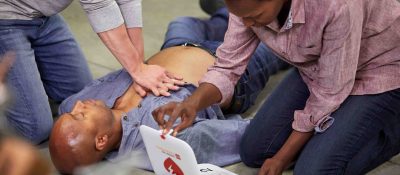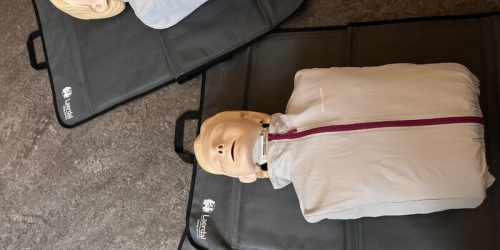CPR Training
CPR for adults, CPR training including use of a defibrillator
During a cardiac arrest outside of a hospital, a key factor for survival is that CPR can be initiated immediately, and that it is done before the ambulance arrives on the scene. It is therefore crucial that as many people as possible are knowledgeable on how to perform CPR and how to use a defibrillator.
How to Perform CPR
To perform CPR on an adult, place your hands one on top of each other in the middle of the chest, between the nipples. Then the chest down 5-6 cm, at a rate of 100-120 BPM, 30 times. Release the chest completely between compressions.
Place two fingers under the patient’s chin and one hand on the forehead, then tilt the head back to create an open airway and pinch around the nose with your thumb and index finger. Cover the patient’s mouth with your mouth and blow air until you see the chest rise. It should be the same amount of air as a normal breath. Give two rescue breaths. Lift your head from the patient between the rescue breaths to get new air.
Continue with sets of 30 chest compressions and 2 rescue breaths until medical personnel arrive, or until the patient is breathing normally.
Remember that to learn the correct technique, it’s necessary to attend a practical CPR training with an instructo
When should you perform CPR?
CPR should be initiated when a person is unconscious and not breathing normally.
It’s important to remember that an unconscious person who is breathing abnormally, such as with slow, shallow, gasping, or snoring breaths, should be treated the same as an unconscious person who is not breathing at all.
No need to check the pulse before starting CPR
If an unconscious person is not breathing normally, CPR should be started immediately. You don’t need to check the pulse before starting CPR.
How to assess consciousness
To determine if someone is conscious, speak to them and gently shake their shoulders. If they do not respond, check to see if they are breathing
How to assess breathing
To check if a person is breathing, place two fingers under the chin and one hand on the forehead, then tilt the head back to create an open airway.
Put your ear close to the patient’s mouth and nose looking at their chest.
- See – If the chest is moving
- Listen for breathing
- Feel – if there is breathing coming from the patient’s mouth and nose.
Do not spend more than 10 seconds checking for breathing, and if normal breathing cannot be detected, begin CPR.
How a defibrillator works
A defibrillator contains two electrodes that should be places on to the chest according to its instructive pictures. The machine then analyzes the heart’s electrical activity and determines whether the person needs a defibrillation.
If needed, the defibrillator charges up and delivers a shock through the patient’s heart. There are two types of debribrillators. Some of them are completely automatic, and will deliver the shock automatically, others are semi-automatic, where the user must press a button to deliver the shock.
If there is no electrical activity in the heart or if the heart has a pulse, the defibrillator will not charge up. Instead, it will recommend continued CPR.
After two minutes, the defibrillator will perform a new analysis of the heart rhythm.
If the patient begins to breathe again after the use of the defibrillator, leave the electrodes in place until medical personnel arrive.

Using a defibrillator can feel intimidating, and it’s a good idea to have received hands-on CPR training. However, it’s important to remember that you cannot administer a shock to a person who has not experienced cardiac arrest. The defibrillator only delivers a shock if it detects a cardiac arrest.
It is important to create an open airway for an unconscious person.
When an unconscious person is lying on their back, there is a risk that the tongue may relax and block the airway. By tilting the head back, the tongue is stretched out and the airway is open.
Whats most important when choosing a CPR training?
Sometimes it can be difficult to sort through all the different types of education available. While there may be some variation in teaching styles between instructors, the most important thing is that the organizer follows the guidelines set by the CPR Council for CPR education.
The main focus of the training should be on practical exercises where you can perform all the necessary techniques with an instructor in a controlled environment. This way, you can remember the techniques, tempo, and force required, even in a highly stressful situation. Muscle memory learning should not be underestimated, and for example, each participant should do at least 240 compressions in one training session.
Research is constantly ongoing, and the guidelines are updated every five years. The current guidelines were released in the autumn of 2021.
What equipment are used on a CPR training
There are various types of CPR training dummies, ranging from simple inflatable models to full-body dummies used for training healthcare professionals. Dummies used for training should have direct feedback built-in for breaths and compressions, so you can know if you need to adjust the technique. For corporate and association training, we have chosen to use the half-body dummies Little Anne from Laerdal, as we think that they provide a great learning opportunity.

In addition to dolls, practicing with a defibrillator is also included in CPR training. We have chosen to use Prestan’s AED Ultratrainer to offer exercises that are as realistic as possible. In addition, we also demonstrate at least one live model to provide you with the best experience possible.
How much is a CPR training?
The price for a CPR training is 5795 SEK (excluding VAT) and is valid for a group of maximum 12 participants.
A First aid and CPR training costs 7795 SEK (excluding VAT) and is valid for a group of maximum 12 participants.
Because we follow the CPR Council’s recommendations, the groups are limited to twelve participants per instructor.
In addition to these two standardized trainings, we often create customized trainings tailored to a specific industry or work situation. Sometimes you may want to limit the content to be relevant to an office environment, but it could also be about expanding or specifying the training, for example, around electric injuries.”
Content CPR Training
We start the course with around 30 minutes of theory where we will discuss the objectives and goals of CPR. We will also cover the action plan, which includes assessing safety of the scene, and checking for consciousness and breathing of the individual, and how to make a call to 112.
The rest of the training will be hands-on where you will have the opportunity to practice compressions and ventilations on dummies in different situations. You will also learn how to use a defibrillator.
The CPR training concludes with how to deal with choking emergencies.
Terms CPR Training
The price for CPR Training is 5795 SEK (excluding VAT).
We follow the guidelines of the CPR council, which states a maximum of 12 participants per instructor.
An instructor will come to your workplace, and the course will take 2 hours.
We are available here
- Enköping
- Eskilstuna
- Mariefred
- Norrtälje
- Nynäshamn
- Nyköping
- Stockholm
- Strängnäs
- Södertälje
- Uppsala
- Vagnhärad
- Värmdö
- Västerås


